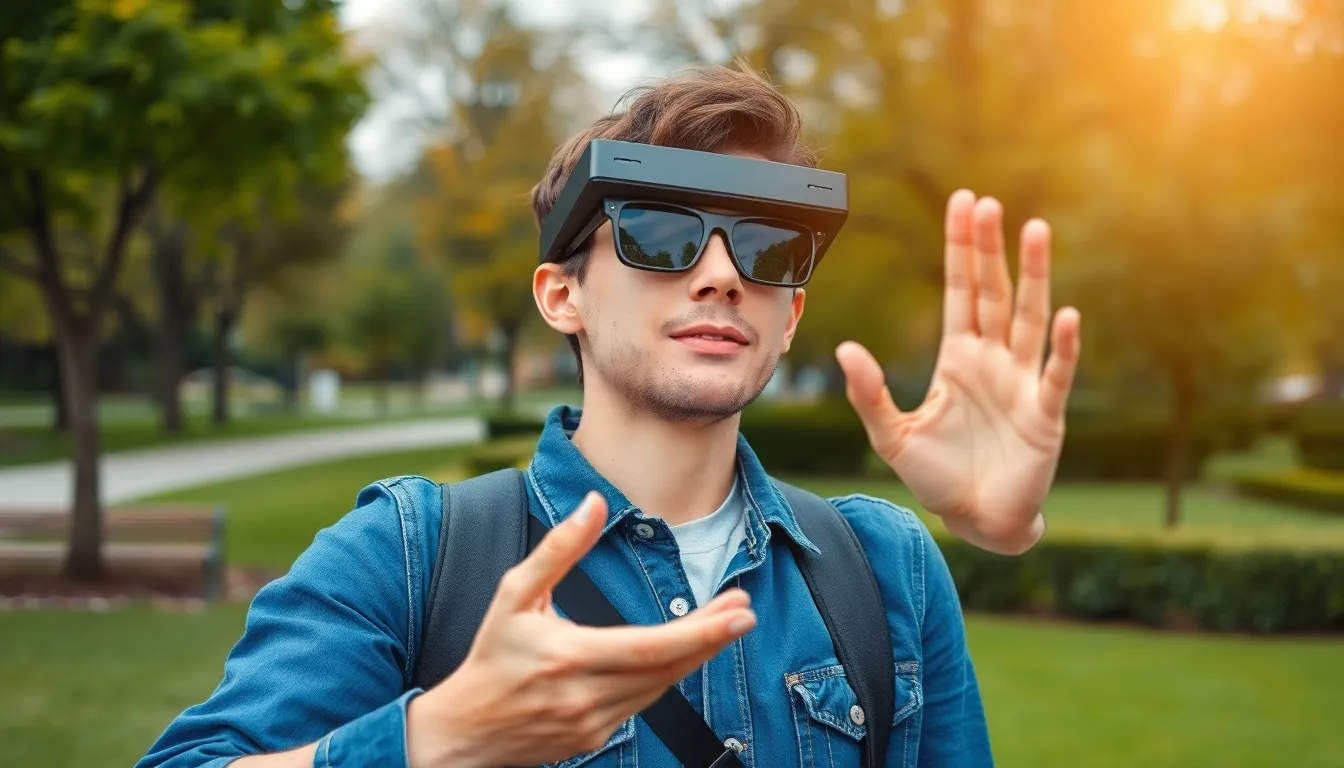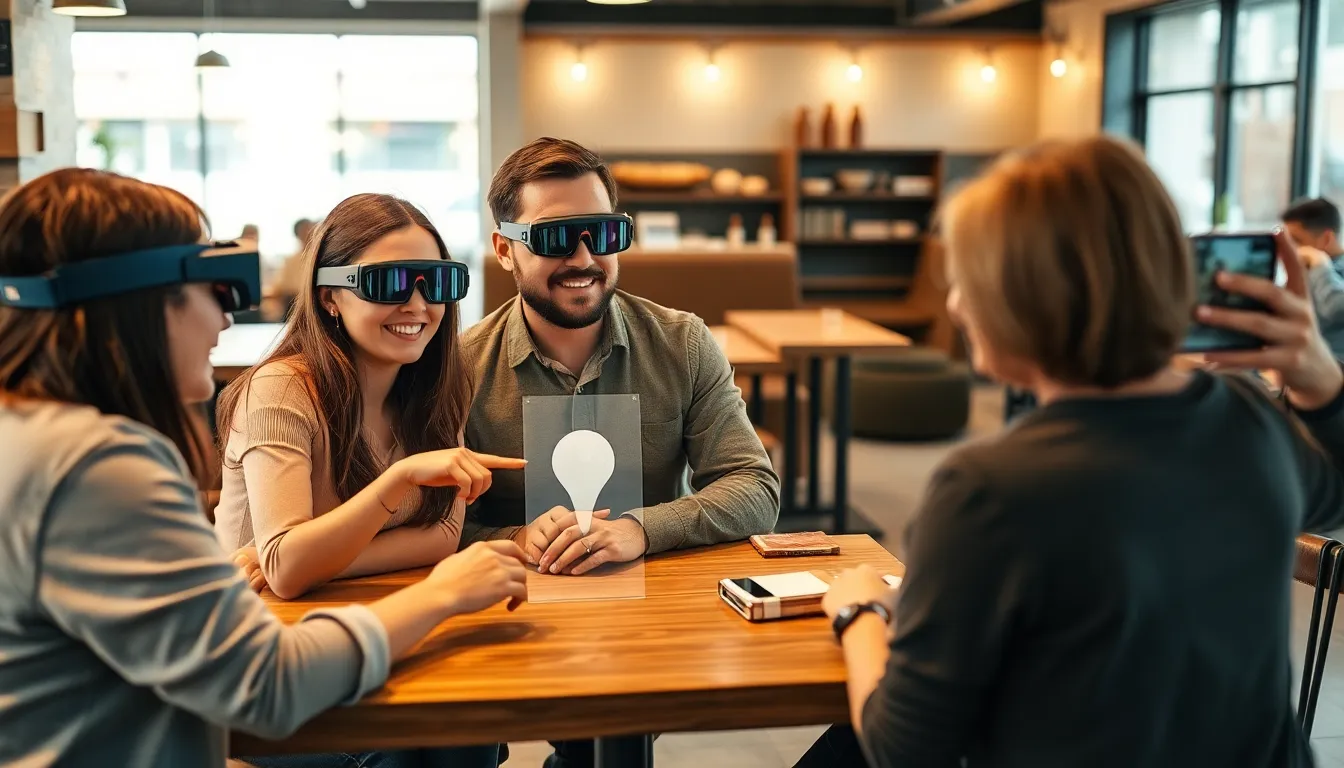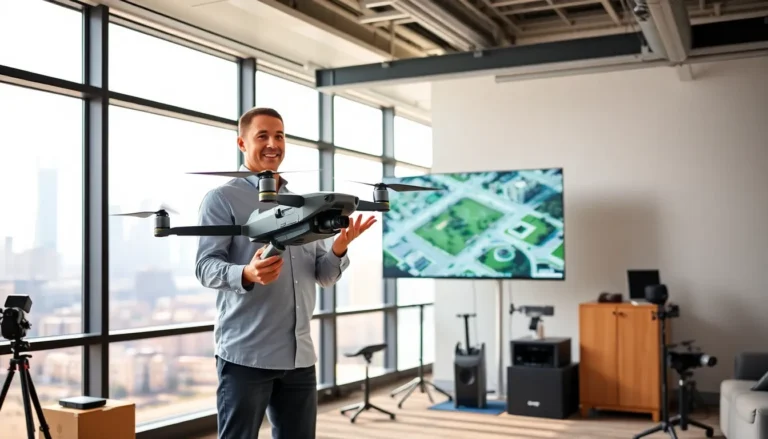In a world where reality often feels a bit too mundane, augmented reality (AR) swoops in like a superhero, ready to spice things up. Imagine blending the digital and physical realms, where your morning coffee could come with a side of animated unicorns. AR development isn’t just for tech wizards anymore; it’s a playground for creatives and innovators alike.
Table of Contents
ToggleOverview of AR Development
Augmented reality (AR) development involves creating applications that overlay digital content onto the physical world. Developers utilize various tools and frameworks to make this seamless integration possible. Popular platforms for AR development include Apple’s ARKit and Google’s ARCore, which provide functionality for tracking and rendering digital objects in real-time.
Developers must consider user experience when designing AR applications. Engaging interfaces enhance interaction between users and digital overlays. They create experiences that are both immersive and easy to navigate, inviting broader participation. For example, a retail application might allow customers to visualize products in their homes before making a purchase.
In addition to mobile applications, developers explore AR in various sectors. Education uses AR to create interactive learning environments, while healthcare applications assist in surgical planning through 3D visualizations. Each sector benefits uniquely from the capabilities AR offers, driving innovation across diverse fields.
Collaboration plays a crucial role in AR development. Developers often work alongside designers, educators, and other stakeholders to gather insights and refine their applications. Feedback from users creates opportunities for continuous improvement and adaptability in features catered to specific needs.
Leveraging machine learning and computer vision enhances AR applications further. These technologies allow for more accurate tracking and interaction between the real and virtual worlds. As AR technology continues to evolve, developers increasingly embrace its potential to transform user engagement and experiences.
Key Technologies in AR Development

AR development relies on a combination of specialized hardware and software tools. These technologies enable the creation of immersive experiences that transform how users interact with their environment.
Augmented Reality Hardware
AR hardware encompasses devices like smartphones, tablets, and smart glasses. Smartphones and tablets serve as primary platforms due to their widespread availability. Smart glasses offer a hands-free experience, enhancing immersion by overlaying digital elements directly in the user’s line of sight. Sensors, cameras, and processors within these devices play crucial roles in tracking the environment and rendering digital content. For instance, devices such as Microsoft HoloLens and Magic Leap One exemplify how advanced hardware can deliver high-quality AR experiences. Each device’s capabilities influence the quality and engagement level of AR applications.
Software Tools for AR Development
Software tools are essential for developing AR applications. Platforms such as Apple’s ARKit and Google’s ARCore provide frameworks for building interactive AR experiences. These tools enable developers to integrate computer vision, motion tracking, and environmental understanding into their applications. Furthermore, Unity and Unreal Engine offer robust support for creating 3D content and animations specific to AR. These engines facilitate rapid prototyping, allowing developers to test ideas efficiently. Additionally, cloud-based services enhance collaborative development, enabling teams to share resources and streamline workflows. Overall, selecting the right software tools significantly impacts the AR development process.
Applications of AR Development
Augmented reality (AR) finds diverse applications across sectors, enhancing user engagement and experiences through innovative interactions.
AR in Gaming
Gaming experiences transform with augmented reality integration. Users engage in interactive gameplay, merging virtual elements with real-world settings. Popular titles like Pokémon GO showcase how AR enables exploration and discovery. Players find themselves immersed in gameplay as they catch virtual creatures in their actual environments. Developers prioritize smooth interactions and rich visuals, ensuring that players feel a seamless blend of digital and physical worlds.
AR in Education
Educational environments benefit significantly from augmented reality tools. Students enjoy immersive learning experiences that promote engagement and retention. Interactive models enhance subjects like biology and history, allowing learners to visualize complex concepts. Applications such as Google Expeditions facilitate virtual field trips, transporting students to historical sites or deep ocean explorations. Teachers leverage AR technology to create dynamic lessons, making education exciting and accessible.
AR in Retail
Retail applications utilize augmented reality to revolutionize shopping experiences. Shoppers visualize products within their homes before making purchases, increasing confidence in their choices. Brands like IKEA offer AR apps that allow customers to see furniture in their spaces, addressing concerns about fit and style. Retailers also enhance customer engagement through virtual try-ons, enabling users to test cosmetics or fashion items seamlessly. These innovative solutions foster personalized shopping experiences, driving sales and customer satisfaction.
Challenges in AR Development
AR development faces several notable challenges. These obstacles can hinder project timelines and impact user satisfaction.
Technical Challenges
Technical challenges in AR development often stem from hardware limitations. Devices may struggle with accurate tracking, leading to decreased immersion. Latency issues can also disrupt user experiences in real-time applications. Furthermore, optimizing graphics rendering for varying device capabilities proves essential. Developers must consider different platforms, as inconsistencies can arise when deploying across multiple systems. Updates and maintenance require attention, as AR technologies continually evolve. Ensuring compatibility with the latest software frameworks is vital for long-term project success.
User Experience Challenges
User experience challenges significantly affect the effectiveness of AR applications. Designing intuitive interfaces remains a primary focus, as users expect seamless interactions. Irrelevant or cluttered interfaces can confuse users, leading to frustration and disengagement. Additionally, addressing varying user skills and familiarity with technology can enhance accessibility. Feedback collection from users is crucial, as it highlights areas for improvement. Balancing digital overlays with real-world environments is essential; overlays that distract or overwhelm users may detract from the core experience. Ultimately, creating a satisfying user journey requires continuous refinement based on evolving user needs.
Future Trends in AR Development
Emerging trends in AR development indicate a shift towards more personalized user experiences. Integration of artificial intelligence enhances content adaptability and responsiveness, allowing applications to tailor experiences based on user behavior and preferences. Advancements in 5G technology support lower latency and faster data transfer, which significantly improves real-time interactions and streamlines AR experiences.
The use of spatial computing gains traction as developers explore ways to create immersive environments that respond to user movements. This technology enables more natural interactions with digital elements, creating a seamless blend between the physical and digital realms. As AR hardware evolves, smart glasses become more sophisticated, featuring enhanced displays and improved tracking capabilities.
Collaboration between developers and industries expands the scope of AR applications across sectors such as entertainment, healthcare, and maintenance. In healthcare, for example, AR aids surgeons by overlaying crucial information during procedures, improving accuracy and efficiency. Maintenance and repair industries utilize AR for providing technicians with real-time data, ensuring quicker and more effective service.
Incorporating augmented reality into social media platforms further fuels user engagement and creative expression. Users interact with immersive content, sharing experiences that blend real-world and digital interactions. This trend encourages brands to create innovative marketing strategies that resonate with consumers.
Sustainability practices emerge as a focus in AR development, leading to eco-friendly applications that promote environmental awareness. Developing AR experiences that educate users about sustainable practices fosters responsible behaviors while enhancing user engagement.
Maintaining user privacy and data security remains a critical concern in AR development. As applications collect and analyze user data, implementing robust security measures ensures the protection of personal information while fostering trust among users.
Augmented reality is reshaping how individuals interact with their surroundings and each other. Its applications span across various sectors from gaming to healthcare and retail, showcasing its versatility and potential for innovation. As developers continue to refine AR technologies and tackle challenges, the focus on user experience and accessibility remains paramount.
Emerging trends in AI integration and 5G advancements promise to enhance real-time interactions and personalize experiences further. Collaboration among industry stakeholders will drive the evolution of AR, ensuring it meets user needs while maintaining privacy and security. The future of AR development is bright, offering endless possibilities for creativity and engagement.





